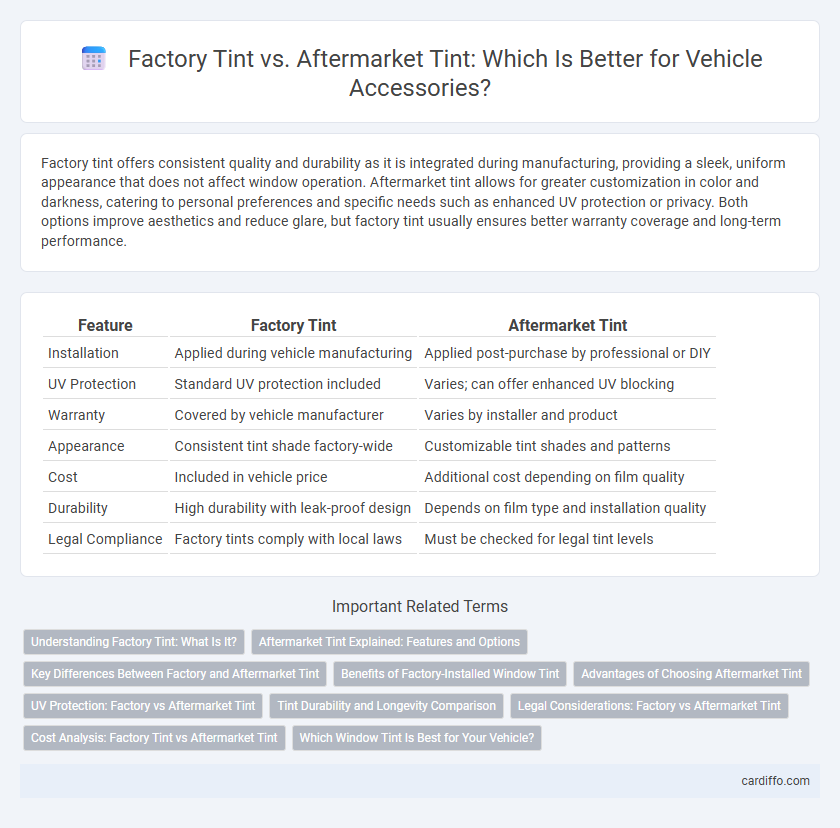Factory tint offers consistent quality and durability as it is integrated during manufacturing, providing a sleek, uniform appearance that does not affect window operation. Aftermarket tint allows for greater customization in color and darkness, catering to personal preferences and specific needs such as enhanced UV protection or privacy. Both options improve aesthetics and reduce glare, but factory tint usually ensures better warranty coverage and long-term performance.
Table of Comparison
| Feature | Factory Tint | Aftermarket Tint |
|---|---|---|
| Installation | Applied during vehicle manufacturing | Applied post-purchase by professional or DIY |
| UV Protection | Standard UV protection included | Varies; can offer enhanced UV blocking |
| Warranty | Covered by vehicle manufacturer | Varies by installer and product |
| Appearance | Consistent tint shade factory-wide | Customizable tint shades and patterns |
| Cost | Included in vehicle price | Additional cost depending on film quality |
| Durability | High durability with leak-proof design | Depends on film type and installation quality |
| Legal Compliance | Factory tints comply with local laws | Must be checked for legal tint levels |
Understanding Factory Tint: What Is It?
Factory tint refers to the tinted glass installed by the vehicle manufacturer during production, featuring a uniform, light shading that reduces glare and UV exposure without significantly darkening visibility. This tint is integrated into the glass itself, enhancing durability and resistance to fading or bubbling compared to aftermarket film applications. Understanding factory tint helps in distinguishing it from aftermarket tint, which involves adding a film layer post-purchase and varies widely in color, darkness, and quality.
Aftermarket Tint Explained: Features and Options
Aftermarket tint offers a wide range of customization options, including varying levels of light transmission, colors, and patterns to enhance vehicle privacy and aesthetics. This tint type often uses high-quality materials such as ceramic, carbon, or dyed films, which improve heat rejection, UV protection, and durability. Professional installation ensures a seamless fit on any vehicle model, making aftermarket tint a flexible and efficient solution compared to factory tint.
Key Differences Between Factory and Aftermarket Tint
Factory tint provides a uniform, light shading integrated during vehicle manufacturing, offering durability and compliance with legal standards. Aftermarket tint allows customization with various shades and materials, often enhancing UV protection and privacy beyond factory options. Installation quality varies significantly in aftermarket tint, affecting longevity and performance compared to consistent factory application.
Benefits of Factory-Installed Window Tint
Factory-installed window tint enhances vehicle value by ensuring consistent quality and durability, as it undergoes rigorous testing during manufacturing. This tint provides superior UV protection and heat reduction due to precise application and uniform film thickness. Unlike aftermarket tint, factory tint maintains optimal visibility and won't peel or bubble over time, ensuring long-lasting performance and aesthetic appeal.
Advantages of Choosing Aftermarket Tint
Aftermarket tint offers superior customization options tailored to specific vehicle models, enhancing aesthetic appeal and UV protection. It typically provides better heat reduction and glare control compared to factory tint, improving driving comfort and safety. Professional installation ensures high-quality finishes and the possibility of upgrading or replacing the tint over time.
UV Protection: Factory vs Aftermarket Tint
Factory tint typically offers basic UV protection integrated within the glass during manufacturing, effectively blocking up to 40% of harmful ultraviolet rays. Aftermarket tint films enhance UV defense, often providing up to 99% UV blockage depending on the quality and type of film applied. Choosing aftermarket tint allows for customizable levels of UV protection, surpassing standard factory settings for improved skin and interior preservation.
Tint Durability and Longevity Comparison
Factory tint typically offers superior durability due to high-quality materials and precise application during vehicle manufacturing, ensuring it withstands UV rays and environmental exposure for many years. Aftermarket tint durability varies widely by brand and installation quality, often lasting between 5 to 10 years before showing signs of fading, bubbling, or peeling. Investing in premium aftermarket films with UV protection and professional installation can significantly enhance longevity, closely matching factory tint performance.
Legal Considerations: Factory vs Aftermarket Tint
Factory tint typically complies with federal and state regulations, ensuring legal levels of light transmission for safety and visibility. Aftermarket tint varies widely in darkness and material, making it essential to verify local tint laws to avoid fines or vehicle inspection failures. Understanding the legal limits on Visible Light Transmission (VLT) percentage is crucial when choosing between factory and aftermarket tint options.
Cost Analysis: Factory Tint vs Aftermarket Tint
Factory tint typically comes included with the vehicle at no additional cost, while aftermarket tinting involves an upfront payment ranging from $100 to $400 depending on the quality and coverage area. Factory tint offers consistent shading adhering to manufacturer standards, reducing long-term maintenance costs compared to some aftermarket options that may fade or peel, potentially requiring replacement. Budget-conscious buyers often choose aftermarket tint for its customizable levels and styles, but factoring in potential reapplication expenses is essential for accurate cost analysis.
Which Window Tint Is Best for Your Vehicle?
Factory tint offers a consistent, light shade directly from the manufacturer, providing moderate UV protection and glare reduction while maintaining optimal visibility. Aftermarket tint allows for customization with various shades and materials, offering enhanced privacy, heat rejection, and UV blockage tailored to personal preferences. Choosing the best window tint depends on factors like desired appearance, functional benefits, local tinting laws, and budget constraints.
Factory Tint vs Aftermarket Tint Infographic

 cardiffo.com
cardiffo.com